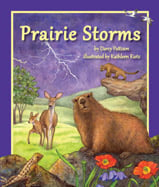Alignment to Standards for DC

| Grade | Number | Standard |
|---|---|---|
| 1 | SC.1.2.1. | Recognize and explain that water, rocks, soil, and living organisms are found on the Earths surface. |
| 1 | SC.1.4. | Different types of plants and animals inhabit the Earth. |
| 2 | G 2.1.1. | Understand how maps and globes depict geographical information in different ways. (G) |
| 2 | SC.2.3.1. | Explain how weather patterns occur continually on Earth. |
| 2 | SC.2.3.2. | Explain that air temperature, humidity, wind speed and direction, and precipitation make up the weather in a particular place and time. |
| 2 | SC.2.3.5. | Explain the difference between weather and climate. |
| 2 | SC.2.3.6. | Describe the differences among the various forms of precipitation (rain, snow, sleet, and hail). |
| 2 | SC.2.3.7. | Cite specific examples of how human beings protect themselves from adverse weather conditions through different means. |
| 2 | SC.2.6. | Plants and animals have structures that serve different functions in growth, survival, and reproduction. |
| 2 | SC.2.6.1. | visible, external features of plants and animals and describe how these features help them live in different environments. |
| 2 | SC.2.7. | Living things depend on one another and their environment for survival. |
| 2 | SC.2.7.1. | Observe and describe how animals may use plants, or even other animals, for shelter and nesting. |
| 2 | SC.2.7.4. | materials in nature, such as grass, twigs, sticks, and leaves, can be recycled and used again, sometimes in different forms, as birds do in making their nests. |
| 2 | SC.2.7.6. | animals and plants sometimes cause changes in their surroundings, some of these changes are easy to see, some are very small and hard to recognize, even though they can be very important. |
| 2 | SC.2.8. | Many different types of plants and animals inhabit the Earth. |
| 2 | SC.2.8.1. | living things are found almost everywhere in the world in habitats such as the oceans, rivers, rain forests, mountain ranges, arctic tundra, farms, cities, and other environments. Recognize that some habitats are extreme, such a |
| 2 | SC.2.8.2. | the numbers and types of living things can vary greatly from place to place. |
| 3 | G 3.1.2. | Identify and locate major physical features and natural characteristics (e.g., bodies of water, land forms, natural resources, and weather) in Washington, DC. (G) |
| 3 | SC.3.5.1. | living things can be sorted into groups in many ways using various properties, such as how they look, where they live, and how they act, in order to decide which things belong to which group. |
| 4 | SC.4.3.2. | Explain how the surface of the Earth changes over various time scales due to processes, such as erosion and weathering, landslides, volcanic eruptions, earthquakes, and mountain building. |
| 4 | SC.4.7.1. | Explain that organisms interact with one another in various ways, such as providing food, pollination, and seed dispersal. |
| 5 | SC.5.4.6. | Explain how global patterns, such as the jet stream and ocean currents, influence local weather and climate in ways that can be measured in terms of temperature, pressure, wind direction and speed, and amounts of precipitation. |
| 5 | SC.5.8. | Many characteristics of an organism are inherited from the parents, but others result from the influence of the environment. |
| 5 | SC.5.8.2. | List some characteristics of plants and animals that are fully inherited (e.g., form of flower, shape of leaves) and others that are affected by the climate or environmental conditions (e.g., browning of leaves from too much sun, language spoken). |
| 5 | SC.5.9.1. | in any particular environment, some kinds of plants and animals survive well, some do not survive as well, and some cannot survive at all. |
| 5 | SC.5.9.3. | Explain how organisms can cause changes in their environment to ensure survival, and how these changes may affect the ecosystem (the living and nonliving components of the environment). |
| 5 | SC.5.9.5. | changes in an organismês habitat are sometimes beneficial and sometimes harmful, and how changes in the environment (drought, cold) have caused some plants and animals to die, migrate, or become extinct. |
| 5 | SC.5.9.6. | many plants and animals can survive harsh environments because of seasonal behaviors (e.g., in winter, some trees shed leaves, some animals hibernate). |
| 5 | SC.5.9.7. | Recognize that some behaviors are instinctive (turtles burying their eggs) and others learned (wolfês hunting skills). |
| K | G K.1. 2. | Demonstrate familiarity with what a map is and what a globe is. (G) |
| K | H K.3. 1. | Identify days of the week and months of the year. |
| K-2 | G K-2.1. | Students use map and globe skills to determine the locations of places. |